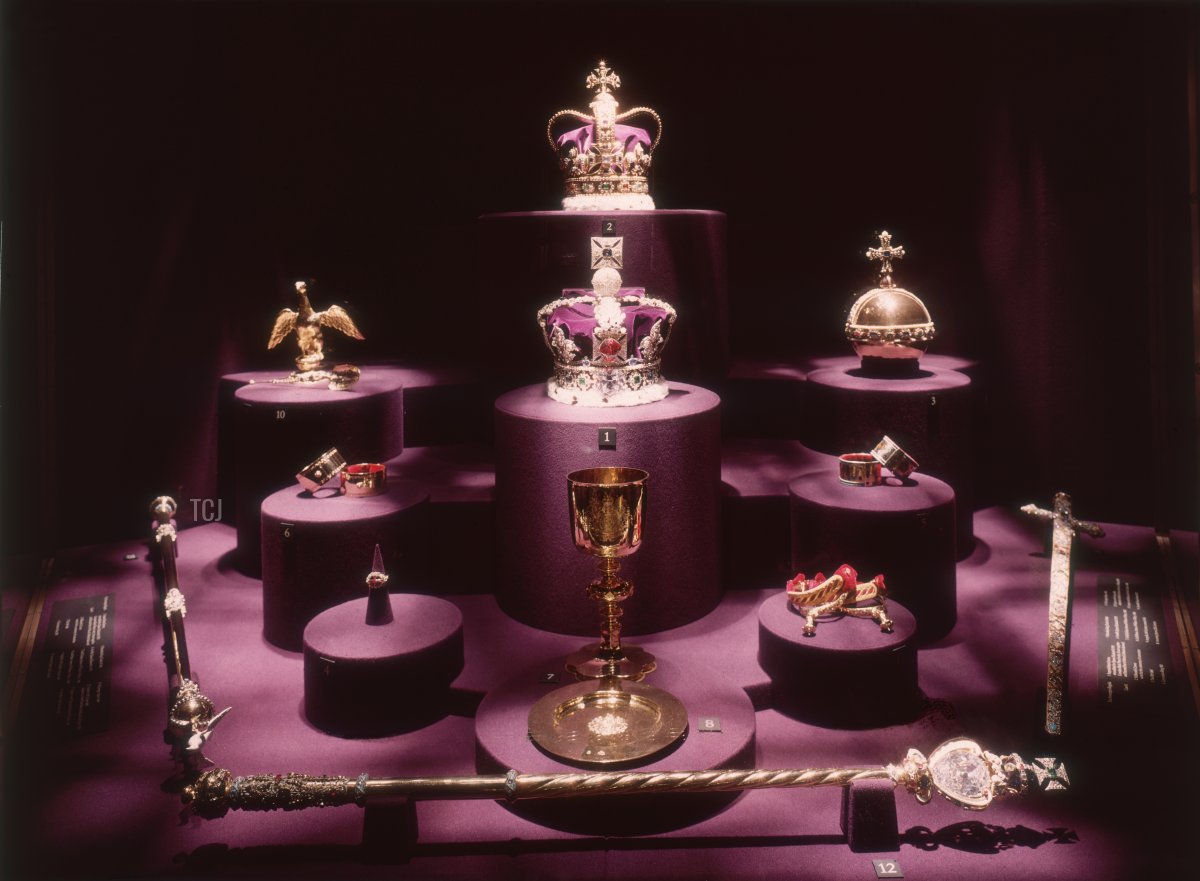
The Jewel House at the Tower of London is going to be looking a bit sparse for the moment, as we’ve learned that nearly all of the traditional coronation regalia will indeed be used for the upcoming coronation. Here’s a closer look at the pieces we’ll see used as King Charles III and Queen Camilla are crowned this May.
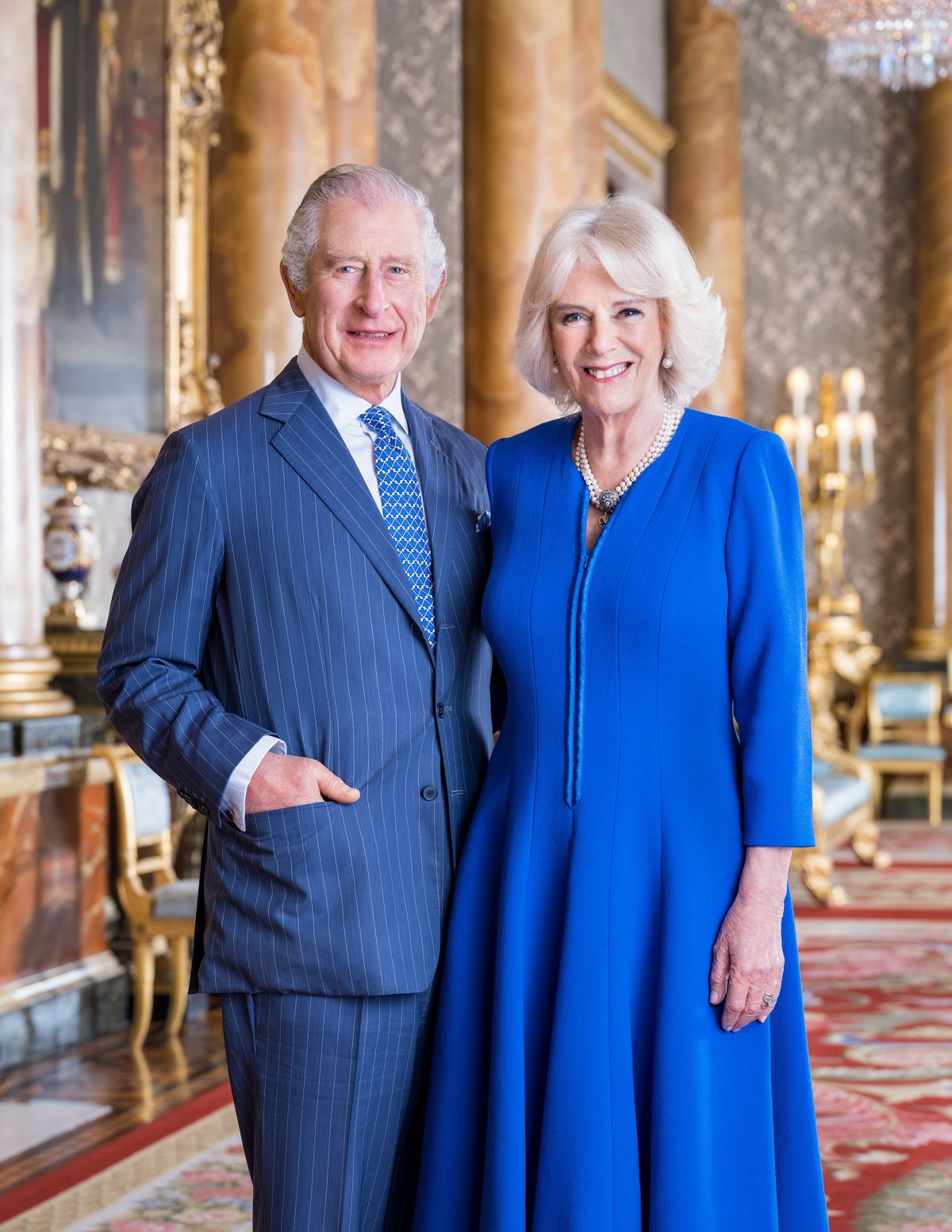
In a recent press release, Buckingham Palace shared more details about the individual pieces of regalia that will be used to crown Charles and Camilla on May 6. “The Coronation Regalia are sacred and secular objects which symbolise the service and responsibilities of the monarch,” the palace explained. The Regalia have played a central role in Coronation Services for hundreds of years and, in keeping with tradition, will be used at Westminster Abbey on the 6th May. As part of the Royal Collection, the Regalia are held in trust by the Monarch on behalf of the nation.”
We’ve been speculating about the regalia that Charles will use for months, so it’s great to get some official news about the matter. Let’s discuss each of the individual pieces and their histories, shall we? Here’s a closer look at the regalia, pretty much in the order we’ll see them appear during the coronation service.
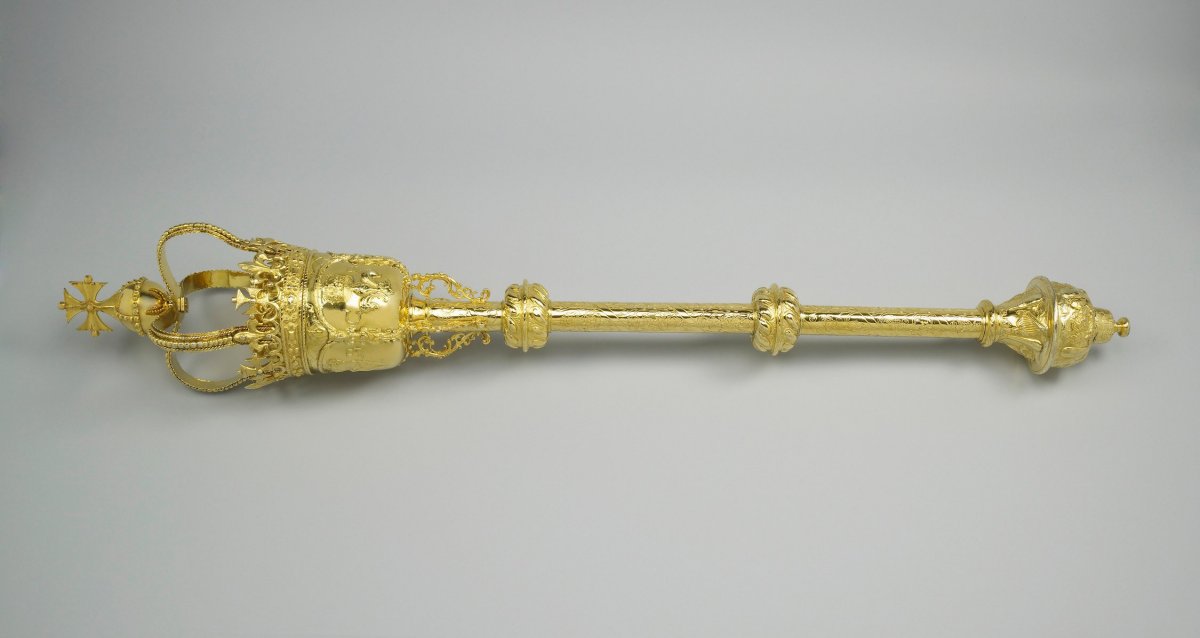
The Maces
The coronation procession into Westminster Abbey will feature numerous pieces of regalia being carried into the building ahead of the monarch. Two gleaming gold maces, carried by a pair of sergeants-at-arms, will be some of the first pieces we see. The mace, made of silver-gilt oak, is a physical symbol of the authority of the monarch. The one pictured above was made for the coronation of King Charles II in 1661. (That coronation featured lots of newly-made regalia pieces, because the old ones had been largely destroyed or dispersed by Cromwell.) There are actually 10 of these maces in the Tower of London, but only two will be used for the coronation.

St. Edward’s Staff
If the coronation procession largely follows the same format that it did back in 1953, the next piece of regalia that we’ll see will be St. Edward’s Staff. It’s a long gold rod with a steel pike on one end. It’s used as a relic of St. Edward the Confessor, the English king whose shrine is at Westminster Abbey. (It had a use in medieval coronations, but that use was not recorded and has not been remembered.) The staff is one of the many pieces of regalia that had to be recreated by Sir Robert Vyner for the coronation of King Charles II in 1661. In 1953, the Earl of Ancaster carried it into the Abbey for the coronation of Elizabeth II.
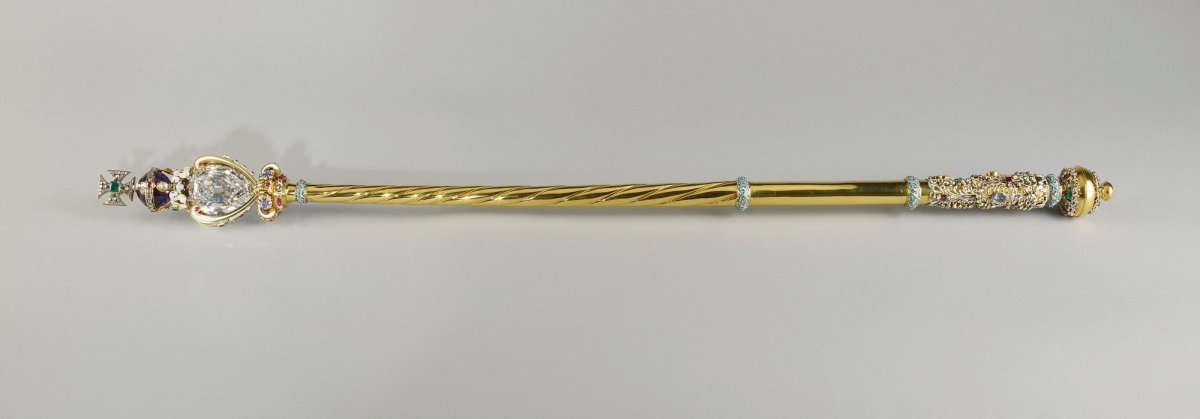
The Sovereign’s Sceptre with Cross
In the 1953 coronation procession, Viscount Portal walked beside Lord Ancaster, carrying the Sceptre with the Cross. The gleaming gold rod is, according to the Royal Collection, a representation of “the sovereign’s temporal power and is associated with good governance.” The jeweled and enameled scepter, which was made by Sir Robert Vyner for Charles II’s coronation in 1661, is set with diamonds, rubies, spinels, emeralds, sapphires, and amethysts. In the early years of the 20th century, the 530.2-carat Cullinan I Diamond was set in the top of the scepter. During the coronation ceremony, the scepter is one of the final regalia pieces handed to the monarch before he is crowned.
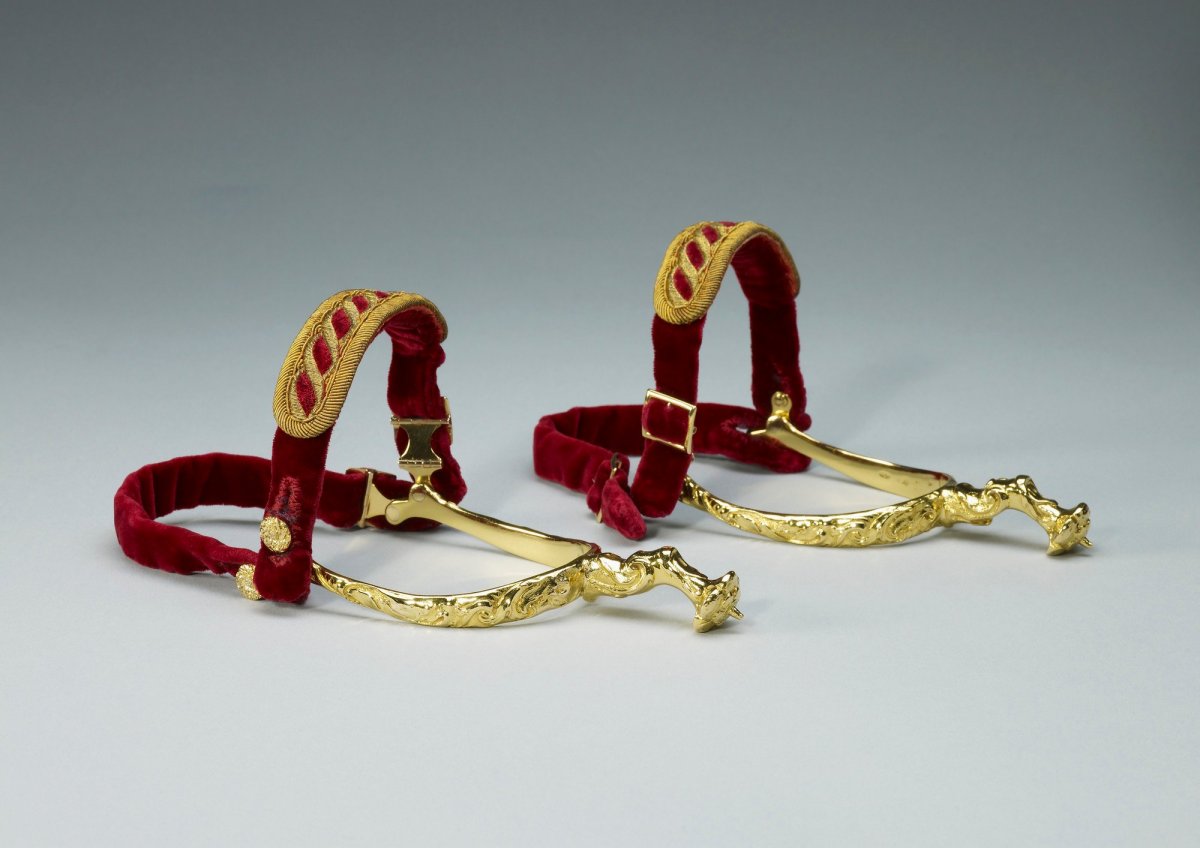
The Spurs
Following the staff and the sceptre in the procession order should be the spurs, made in 1661 by Sir Robert Vyner for Charles II and then altered in 1820 for the coronation of George IV. The spurs symbolize knighthood and chivalry, and their presentation is linked to the monarch’s role as head of the armed forces. In 1953, they were carried in to the Abbey by Lord Hastings and Lord Churston. During the coronation ceremony, they’re brushed against the monarch’s feet before he is crowned.
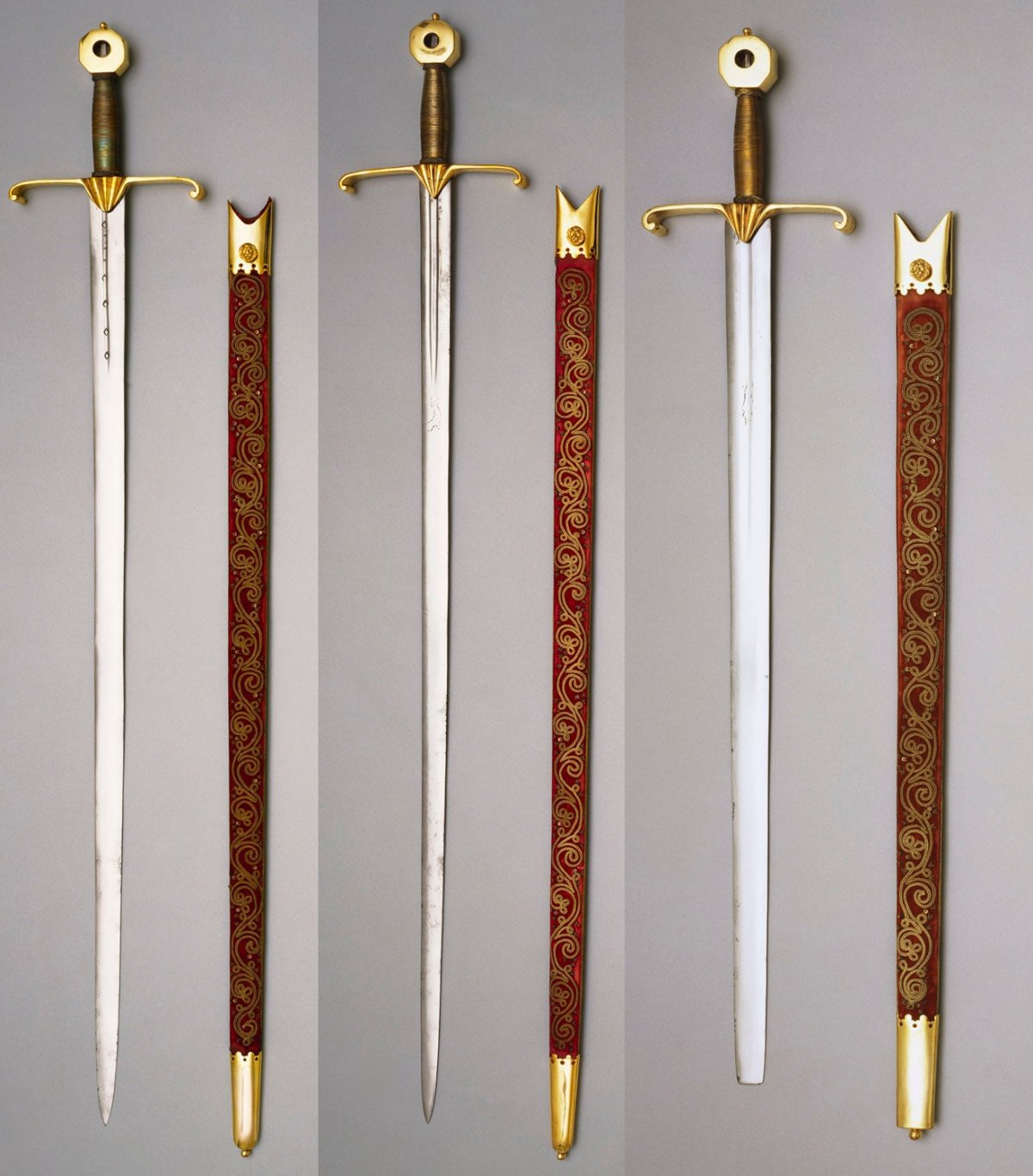
The Sword of Temporal Justice, the Sword of Spiritual Justice, and the Sword of Mercy
The spurs were followed in the 1953 procession by three symbolic swords, all made in the early 1600s by a pair of Italian swordmakers. They’re actually three of only four regalia pieces that survived the English Civil War and Cromwell’s republic unscathed. Together, the three swords symbolize the kingly virtues, and the practice of carrying the trio together (unsheathed, pointed toward the sky) dates to the 1100s. From left to right, the swords signify secular justice, spiritual justice, and mercy—the last of which is also known as the curtana, a sword with a symbolically blunted end. In 1953, the swords were carried into the Abbey by the Duke of Buccleuch, the Earl of Home, and the Duke of Northumberland.
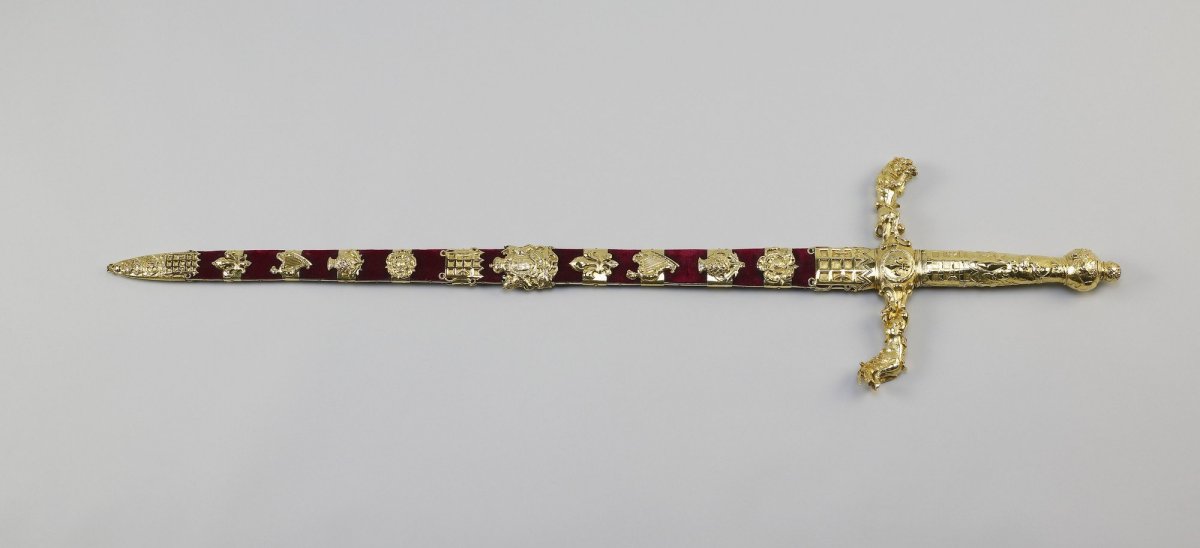
The Sword of State
The three swords are followed by one larger and even more significant sword: the Sword of State. It was made for Charles II in 1678, and it’s sheathed in a special scabbard made in 1689 for William III. This sword, like so many other regalia pieces, symbolizes the monarch’s authority. The Marquess of Salisbury carried the sword in the 1953 coronation procession. You’ll see it carried in processions on some other royal occasions as well, notably the State Opening of Parliament. And King Charles has seen the sword up-close on another important occasion, too. His mother, Queen Elizabeth II, used the sword during his investiture as Prince of Wales in 1969.
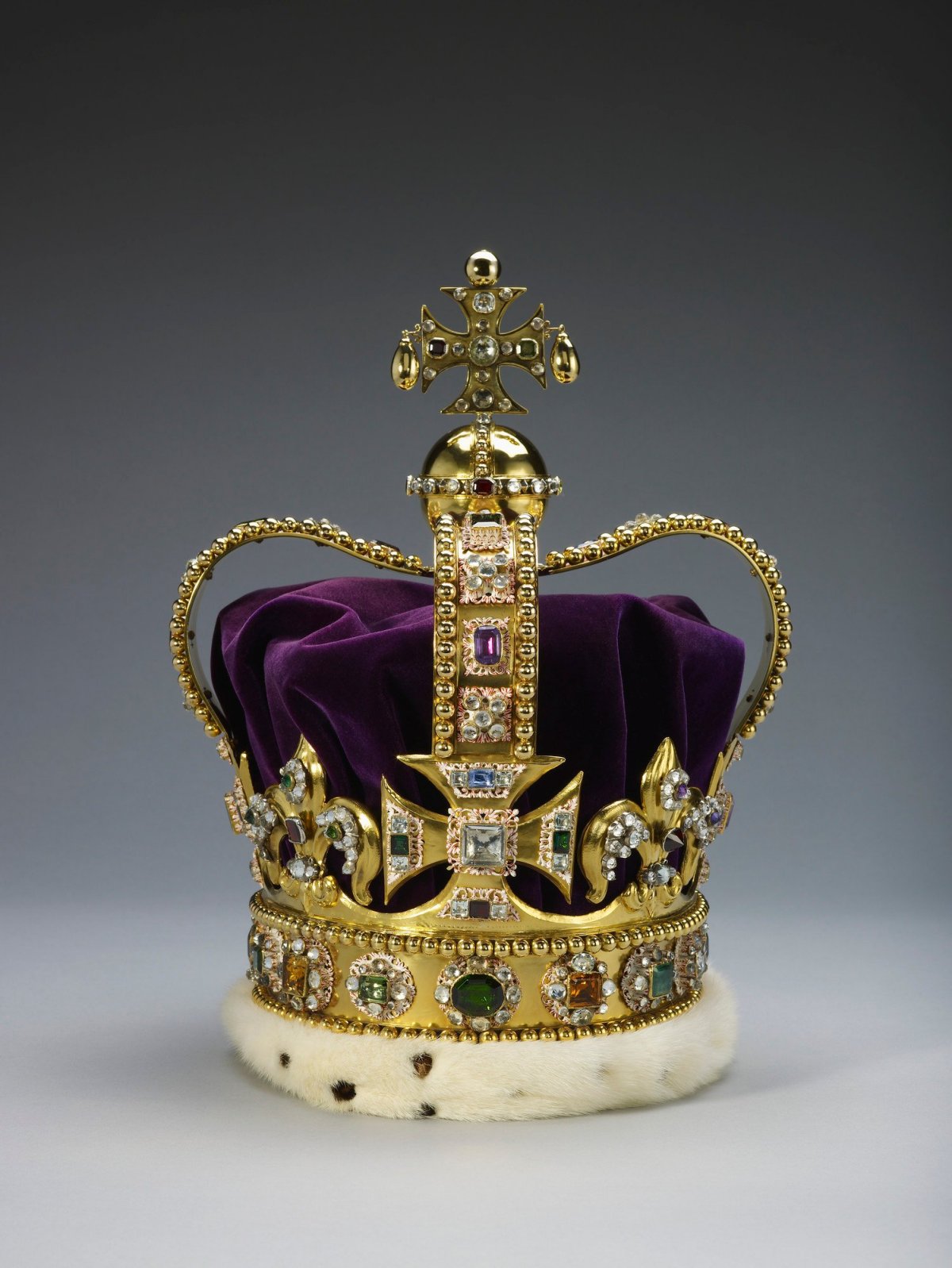
Behind the Sword of State in the coronation procession comes the most important regalia piece of all: St. Edward’s Crown, which is used to crown the monarch during the ceremony. (It’s already been adjusted to fit Charles’s head.) It’s the only time that this specific crown is worn during a monarch’s reign. This crown dates to the coronation of Charles II in 1661, but it’s based on the earlier medieval crown that was destroyed following the Civil War. It’s solid gold, set with tourmalines, white and yellow topazes, rubies, amethysts, sapphires, garnets, peridots, zircons, spinels, and aquamarines. In 1953, the person carrying it in the coronation procession was Viscount Cunningham, the Lord High Steward.
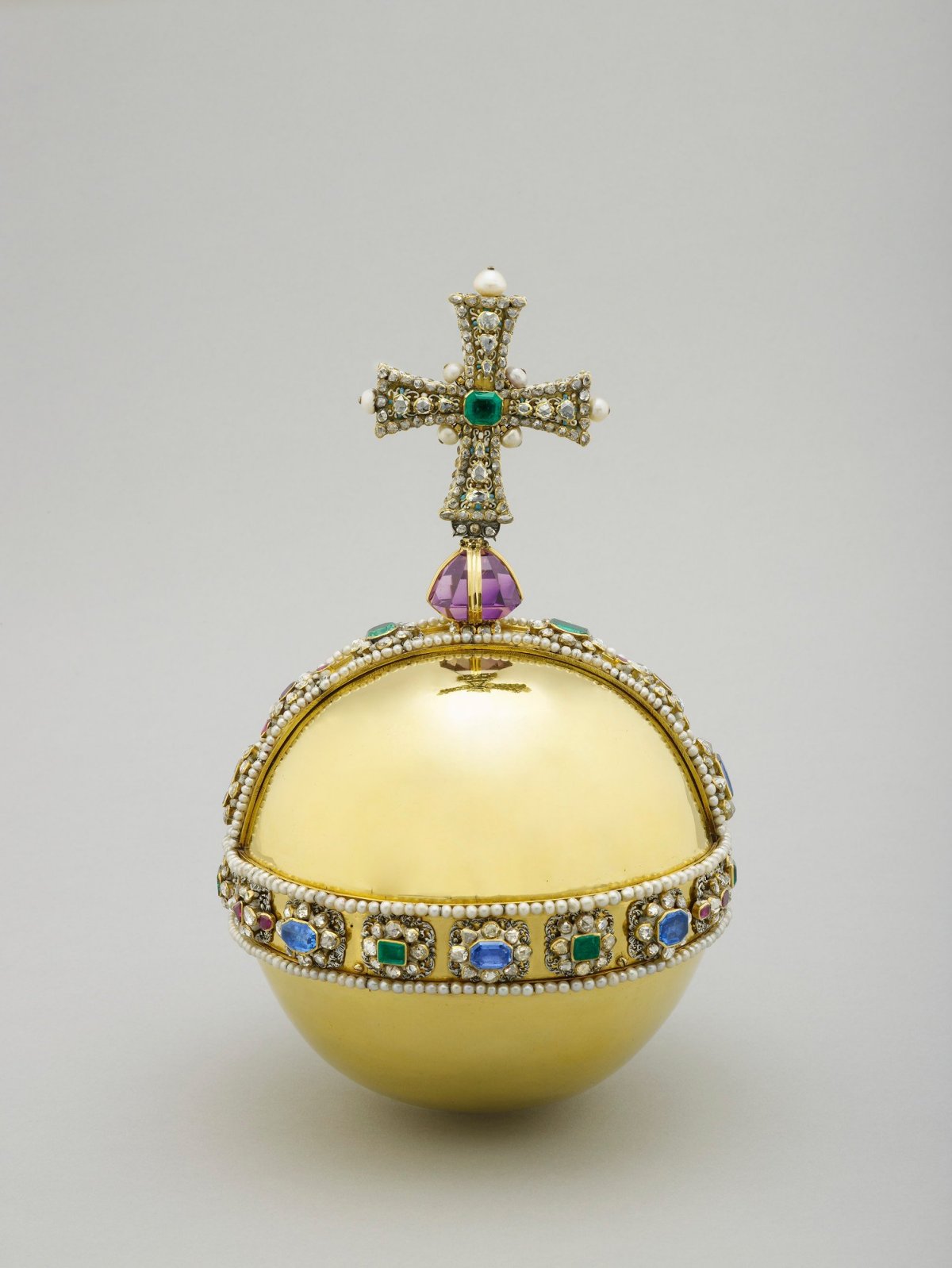
The Sovereign’s Orb
Two more pieces of regalia accompany St. Edward’s Crown down the aisle of the Abbey during the procession. On the right is the Sovereign’s Orb, which symbolizes the power of the monarch. The Royal Collection explains, “It symbolizes the Christian world with its cross mounted on a globe, and the bands of jewels dividing it up into three sections represent the three continents known in medieval times.” In 1953, it was carried in the procession by the Earl Alexander of Tunis. The golden orb, which is set with pearls, diamonds, rubies, emeralds, sapphires, and a single large amethyst, was made in 1661 by Sir Robert Vyner for the coronation of Charles II. The orb is placed in the monarch’s hand as he is invested with the regalia just before the moment of crowning during the ceremony. During the procession out of the Abbey after the ceremony, the monarch carries the orb in his left hand.
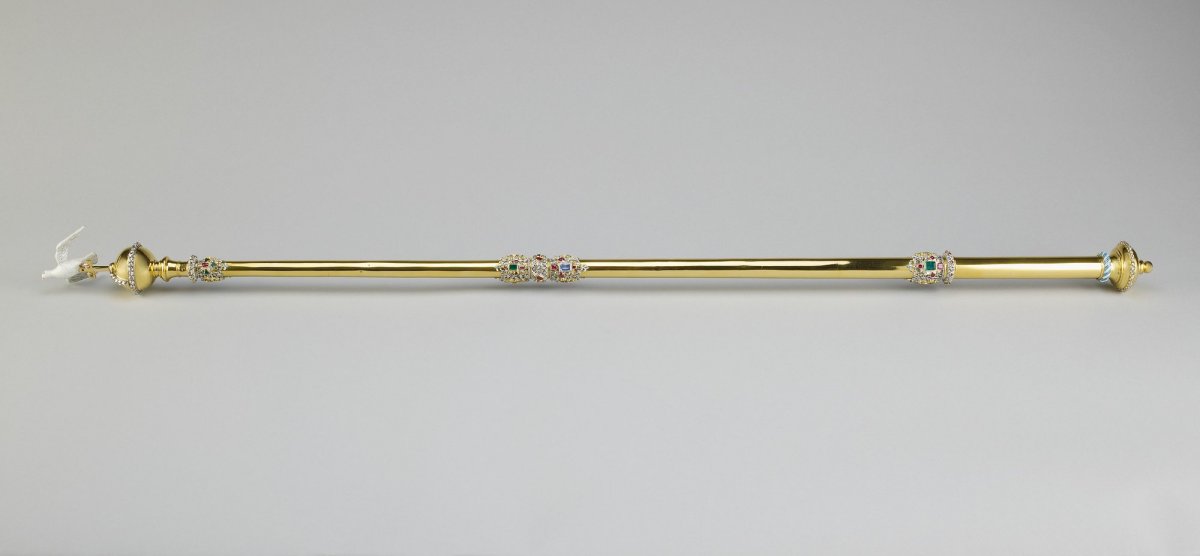
The Sovereign’s Sceptre with Dove
On the other side of St. Edward’s Crown during the procession is the Sovereign’s Sceptre with Dove, another 1661 creation that symbolizes the monarch’s spiritual role. The dove represents the Holy Spirit, and the Royal Collection notes that the scepter has also traditionally been known as “the Rod of Equity and Mercy.” It was carried by the Duke of Richmond in the 1953 procession. Along with the Sovereign’s Sceptre with Cross, it is the last piece of regalia handed to the monarch before he is crowned.
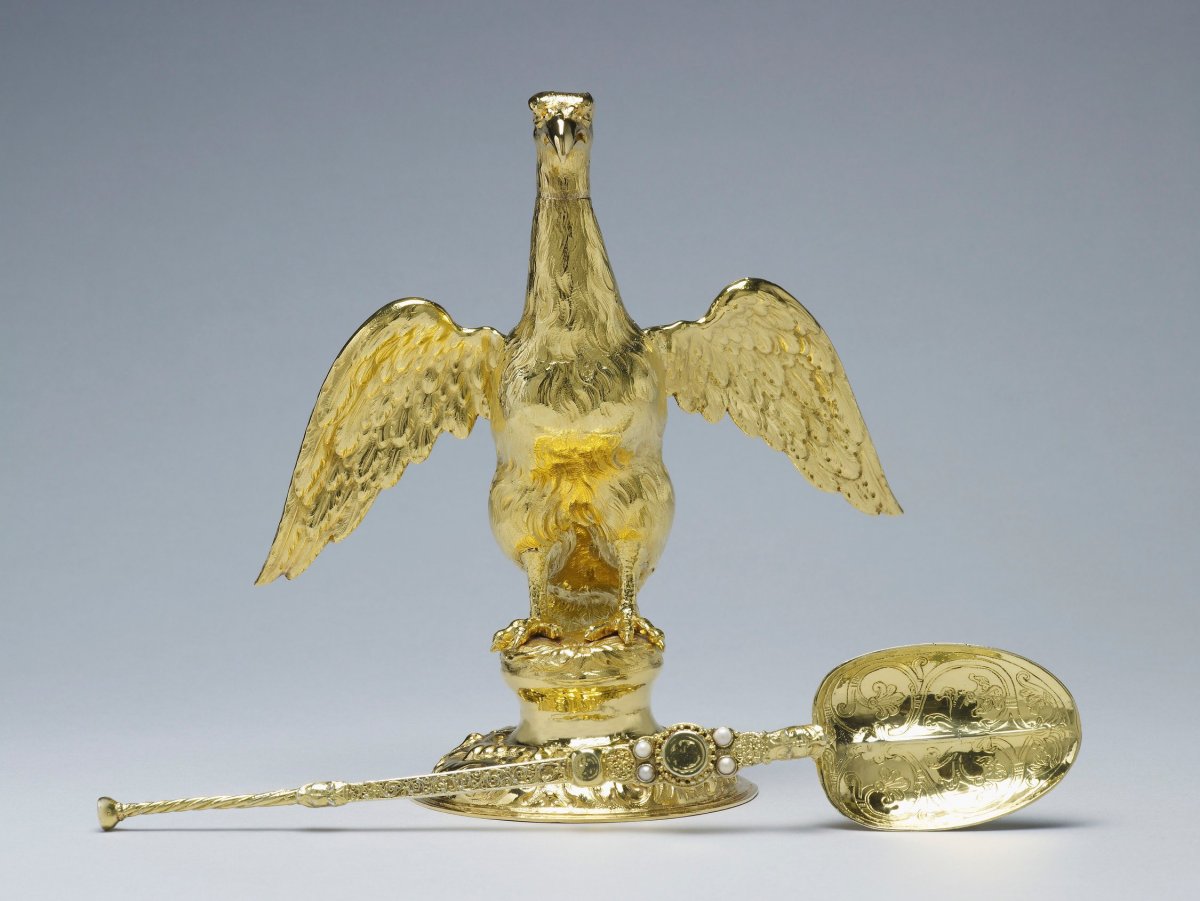
The Ampulla and the Spoon
Throughout the ceremony, other pieces of regalia are also used. The eagle-shaped gold ampulla holds the consecrated oil used to anoint the monarch. (The oil is poured out through the bird’s beak.) Like so many other pieces of coronation regalia, it was made in 1661 by Sir Robert Vyner for the coronation of Charles II. But the silver-gilt coronation spoon, into which the consecrated oil is poured, is much, much older. It’s the fourth and final piece of the regalia that survived the interregnum period. Made in the second half of the 12th century, it was sold off after the Civil War and then returned to Charles II by the buyer after the Restoration. It was Charles who had the small pearls added to the spoon.
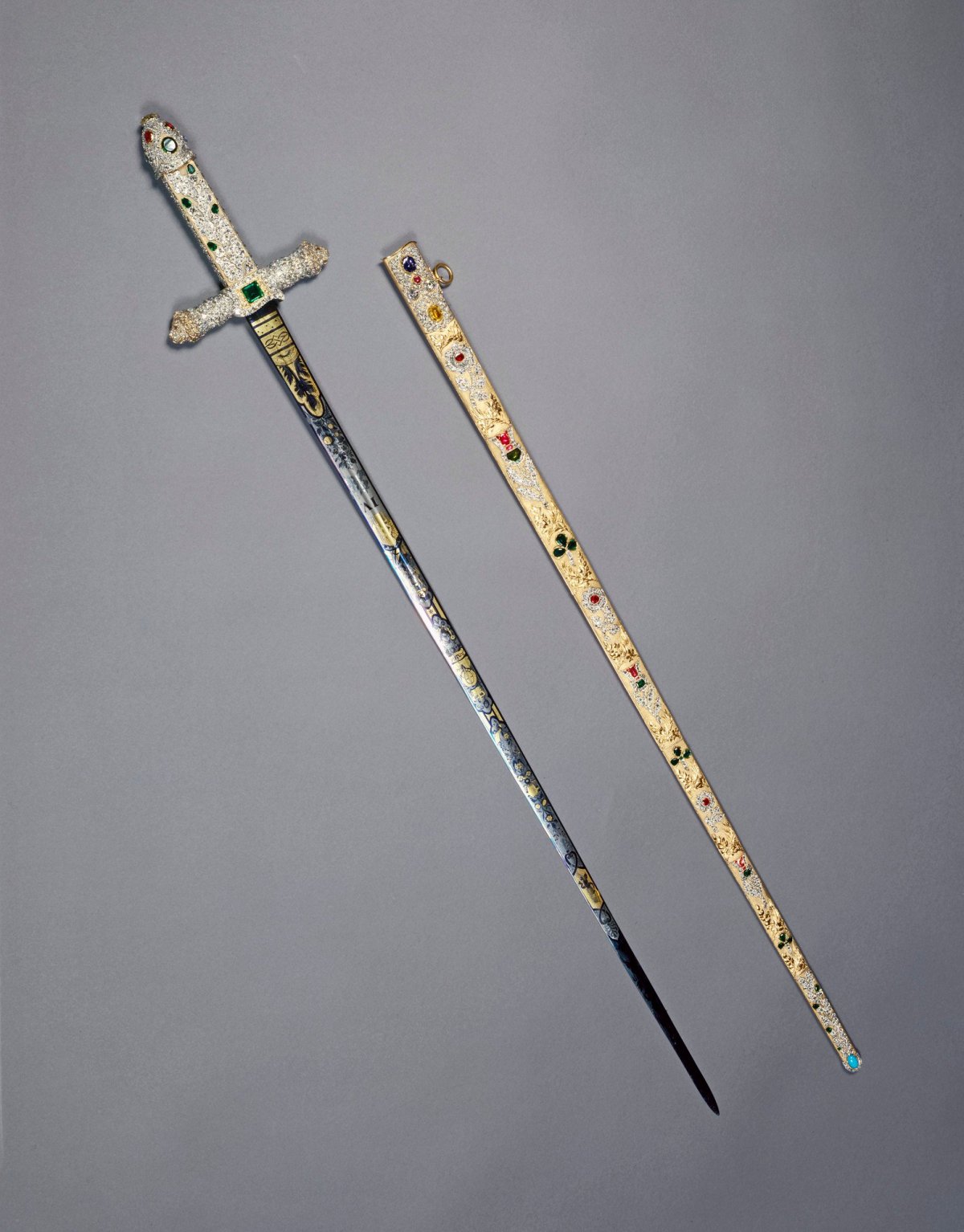
The Sword of Offering
During the coronation ceremony, the Sword of State is swapped out for yet another sword: the Jewelled Sword of Offering. This sword dates to 1820 and the coronation of King George IV. It was made by Rundell, Bridge, & Rundell, and is set with diamonds, rubies, emeralds, and turquoises. It arrives in the Abbey with the Keeper of the Jewel House, along with the armills and the coronation ring. During the ceremony, the sword represents the punishment of evil and the restoration of goodness. The Archbishop of Canterbury hands it to the monarch, exhorting him to enact justice, restore order, and enforce goodness. The monarch then rises from the coronation chair to place the sword on the altar, symbolically placing worldly power at the altar of God. In 1953, after the Queen placed the sword on the altar, Lord Salisbury symbolically redeemed it by offering a traditional payment of coins to the Dean of Westminster. Afterward, he held the jeweled sword for the rest of the service.
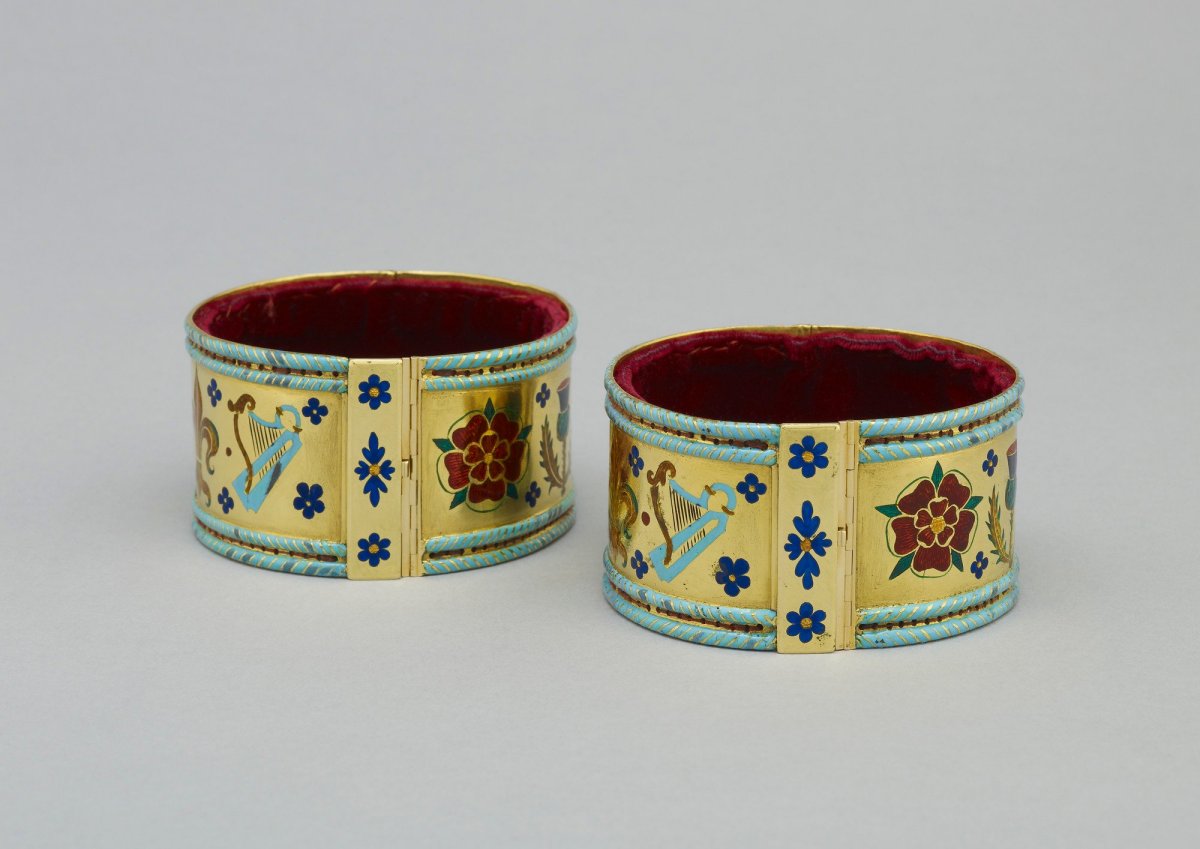
Next, the Archbishop fastens the armills on the monarch’s wrists. These gold and enamel bracelets were made in 1661 for the coronation of Charles II, and they were part of all subsequent coronations until 1953. That year, a new set of gold armills were made for Elizabeth II as a gift from the people of Australia. I’m a bit surprised that Charles has decided not to wear his mother’s armills, but he apparently wishes to go back to the traditional seventeenth-century set. They’re traditionally known as the “bracelets of sincerity and wisdom.”
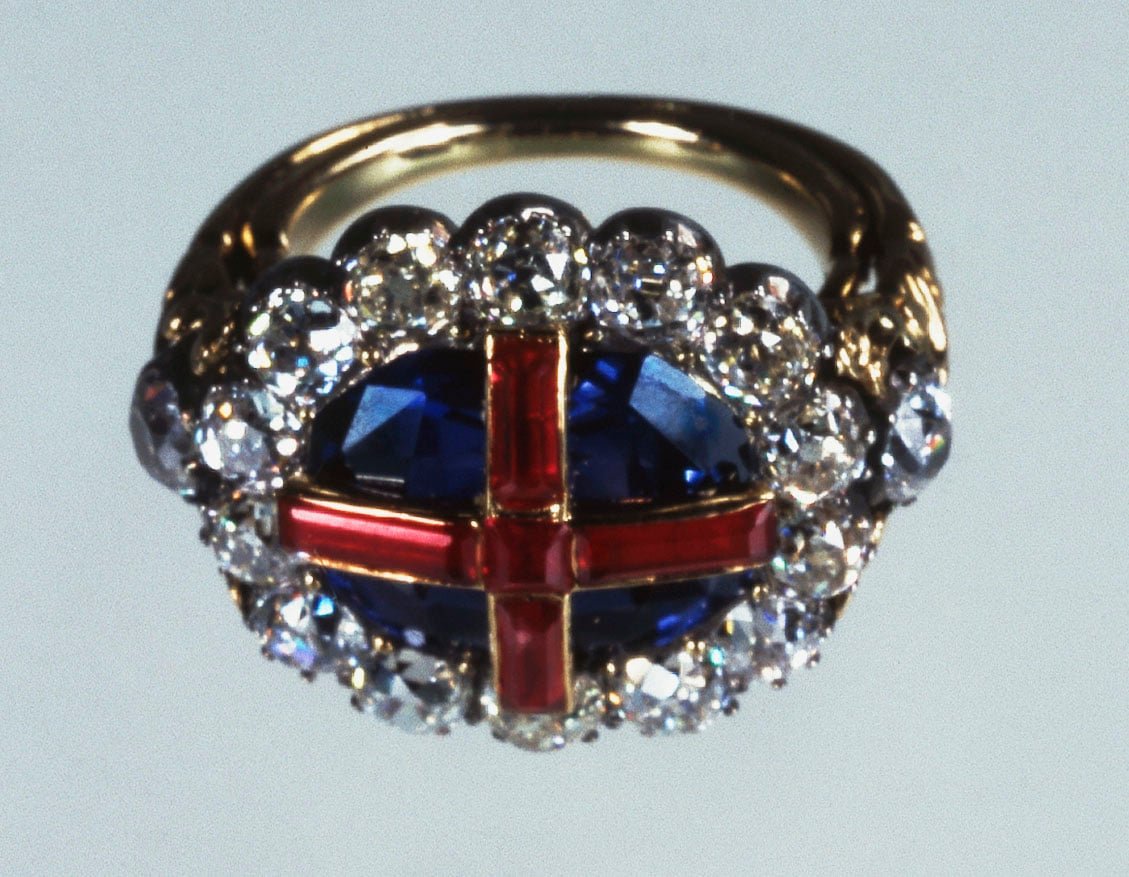
The orb is handed to the monarch next, and then the Archbishop places the Sovereign’s Ring on the monarch’s hand. It’s a symbol of the marriage between the monarch and the people. The ring, made by Rundell, Bridge, & Rundell, dates to 1831, when it was made for the coronation of King William IV. The diamond, sapphire, and ruby ring is a symbol of “kingly dignity,” according to the Royal Collection. It’s one of the final pieces of regalia presented to the monarch before he is crowned. Next come the gauntlet glove and the two scepters, and then the Archbishop of Canterbury places St. Edward’s Crown on the king’s head.
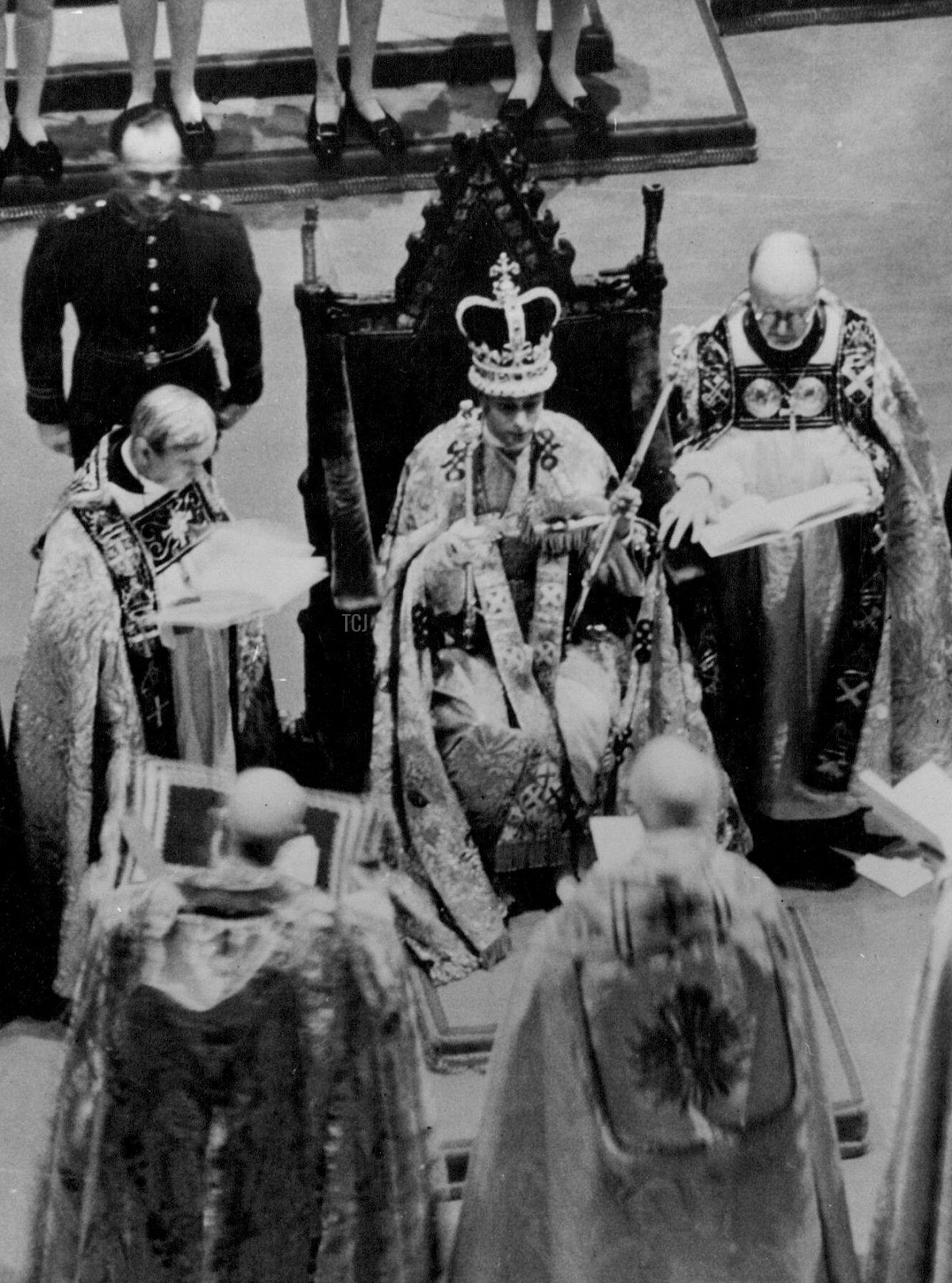
We last saw a King crowned in Westminster Abbey on May 12, 1937, when King Charles’s grandfather, King George VI, was crowned there. Here, he wears St. Edward’s Crown and holds the two scepters during the coronation service.
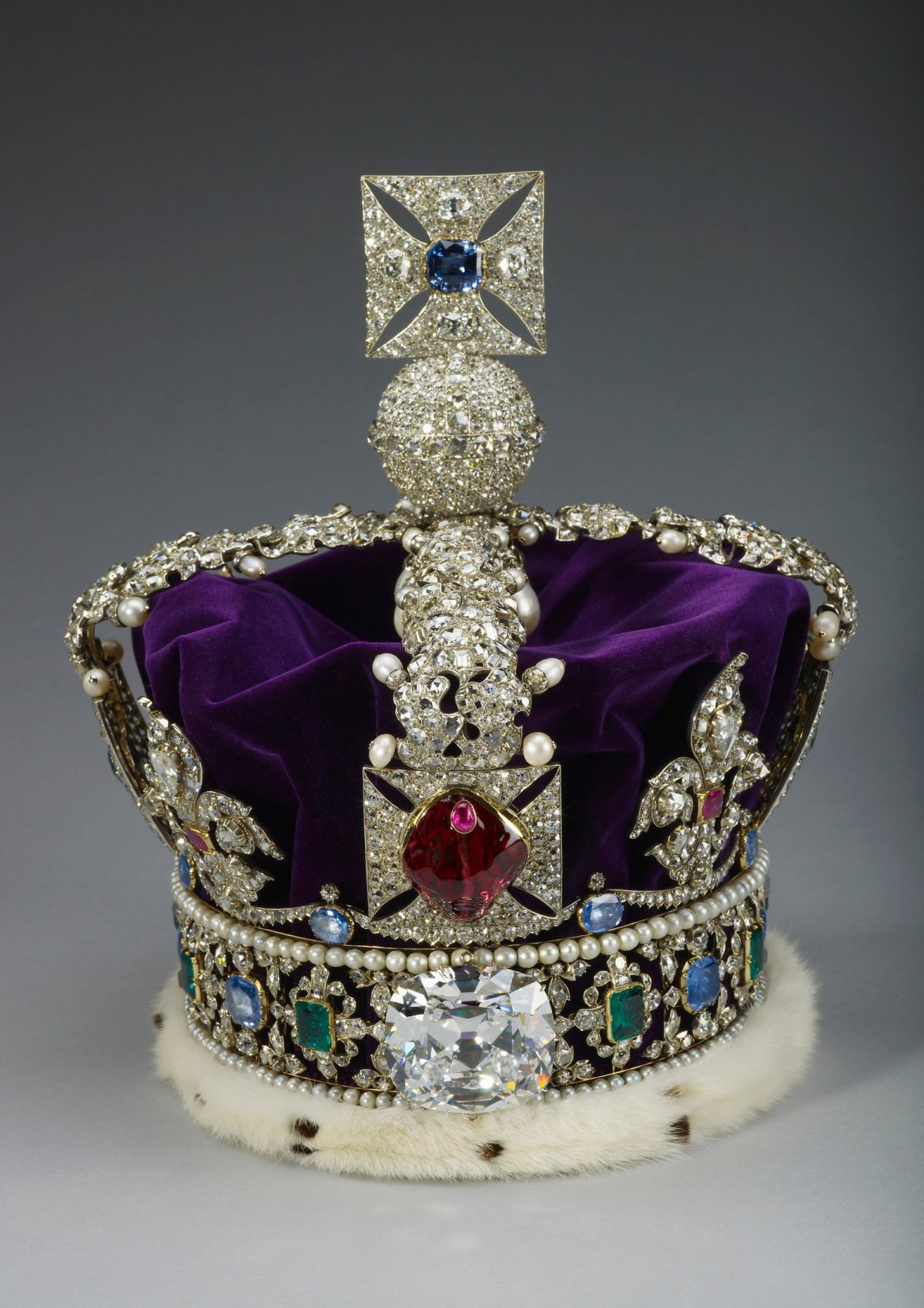
Before leaving the Abbey, the monarch does a crown switcharoo. St. Edward’s Crown is removed and replaced with the Imperial State Crown. This particular state crown was made in 1937 for King George VI, but it was based very closely on the design of the crown made for Queen Victoria a century earlier. It’s significantly lighter than St. Edward’s Crown. The monarch wears it as he leaves the Abbey and processes through the streets of London after the service. Several famous jewels are set in this crown, including the Black Prince’s Ruby, the Cullinan II Diamond, and the Stuart Sapphire.
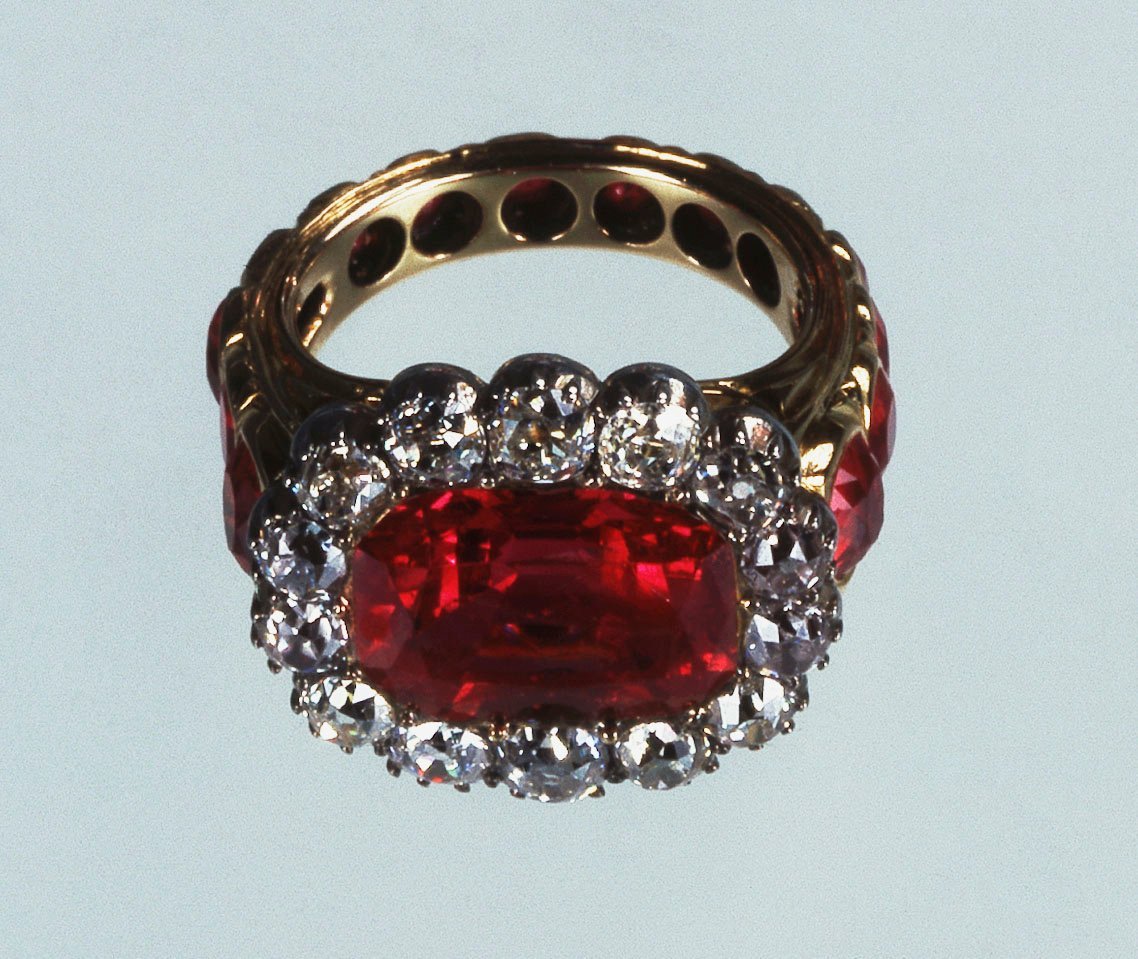
For the first time since 1937, we’ll also see a queen consort crowned at Westminster Abbey during the coronation. Queen Camilla will use a smaller (but still impressive and interesting) set of regalia during her crowning. First, after she is anointed under a canopy, the Archbishop will place the Queen Consort’s ring on her right hand. The ruby and diamond ring that will be used is the one made by Rundell, Bridge, & Rundell for Queen Adelaide, consort of King William IV, in 1831. It’s been used by all queens consort since 1900 (Alexandra, Mary, and Elizabeth).
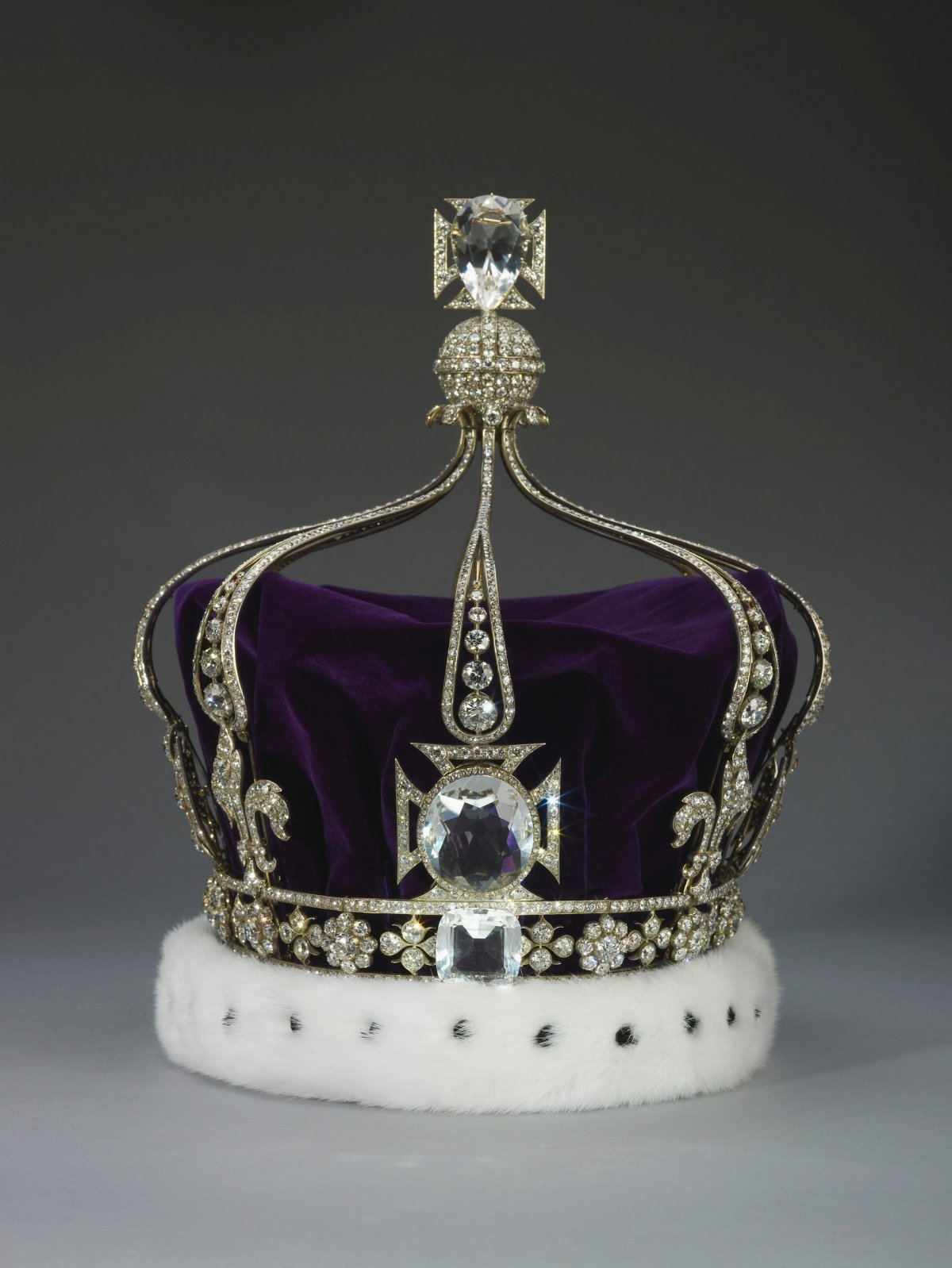
Queen Camilla will then be crowned by the Archbishop. She has chosen to be crowned with the coronation crown made for Queen Mary by Garrard in 1911. Queen Mary always wanted her crown to become the official crown used for queens consort, so this decision fulfills that wish. But some changes will have been made to the crown by the time we see Camilla wear it on May 6. Four of the arches will be removed, and three large crystals currently set in the crown (copies of the Koh-i-Noor, Cullinan III, and Cullinan IV Diamonds) will be removed and replaced with the genuine Cullinan III, IV, and V Diamonds. (You can read much more about the crown and the changes over here.)
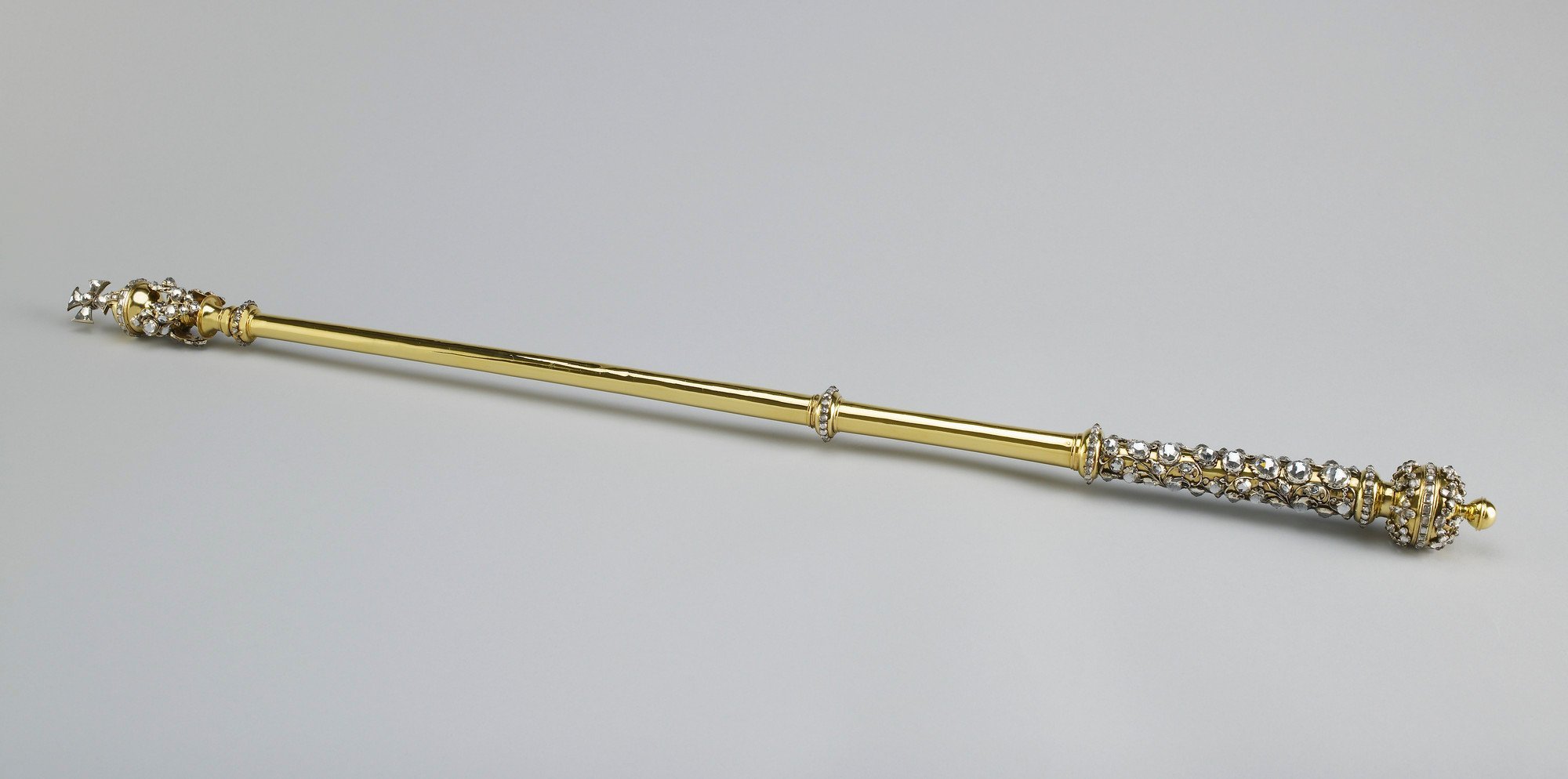
The Queen Consort’s Sceptre with Cross
After she is crowned, the Archbishop will put the Queen Consort’s Sceptre with Cross in Camilla’s right hand. This is part of the regalia made by Sir Robert Vyner for Mary of Modena, consort of King James II, in 1685. It’s made of gold and set with rock crystals. (The original diamonds were removed after the 1685 coronation, because they had been borrowed rather than purchased outright.)
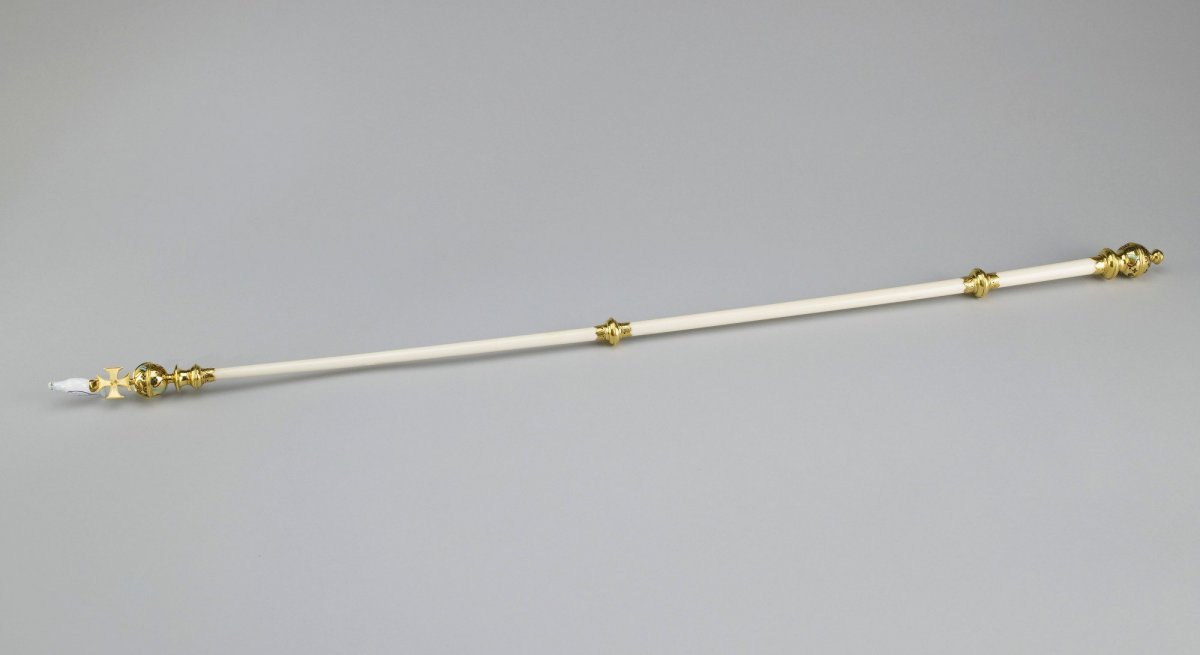
The Queen Consort’s Rod with Dove
The Archbishop will then place the Queen Consort’s Rod with Dove into her left hand. The rod was also made for Mary of Modena in 1685 and has been used by each queen consort who has been crowned over the centuries since then. The rod is made of gold and ivory.
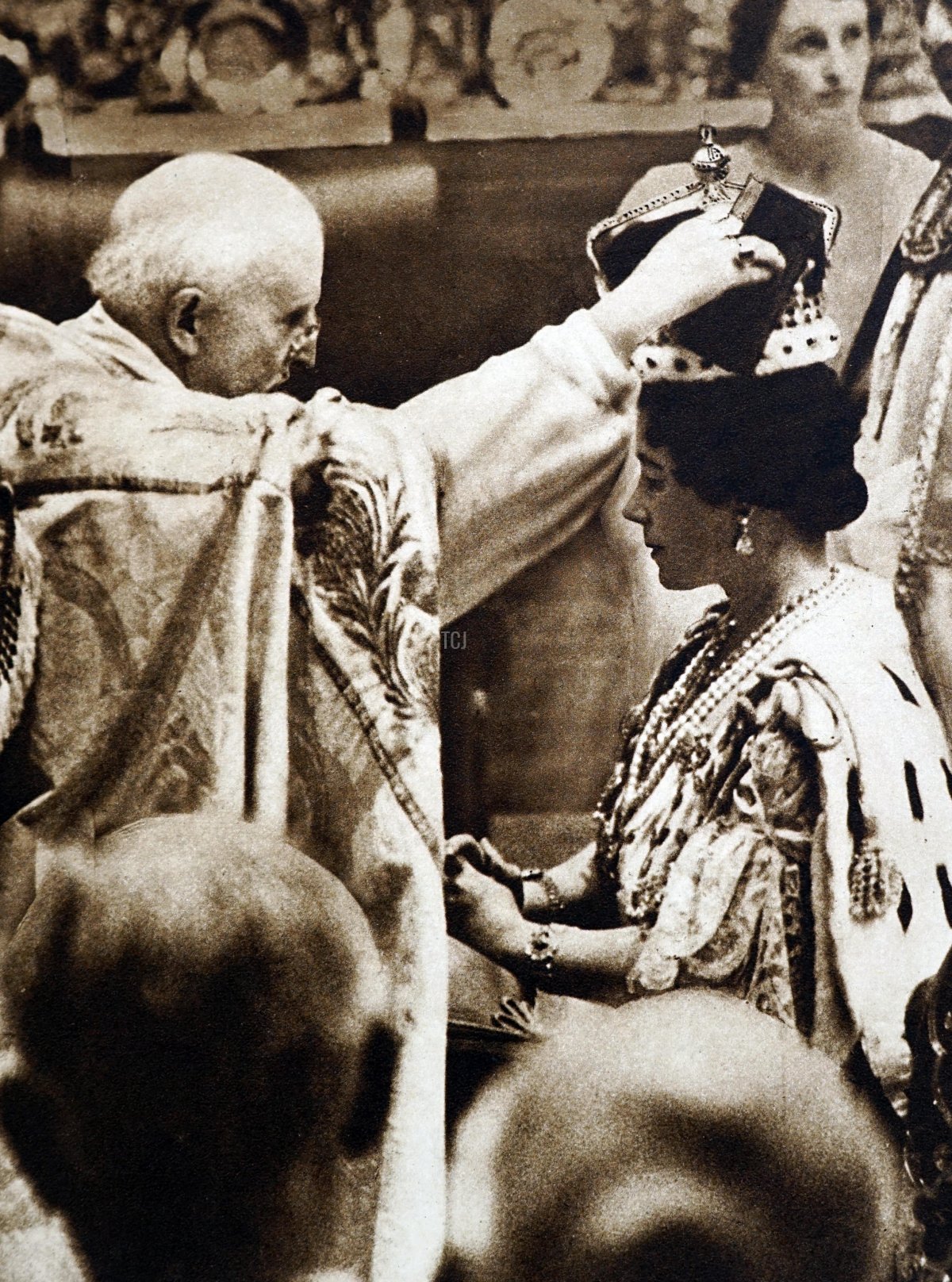
Here’s a look at the most recent queen consort to be crowned: Queen Elizabeth (later the Queen Mother) in May 1937. She had a new coronation crown made for her use (because Queen Mary was attending the ceremony and decided to wear her crown in its circlet form).
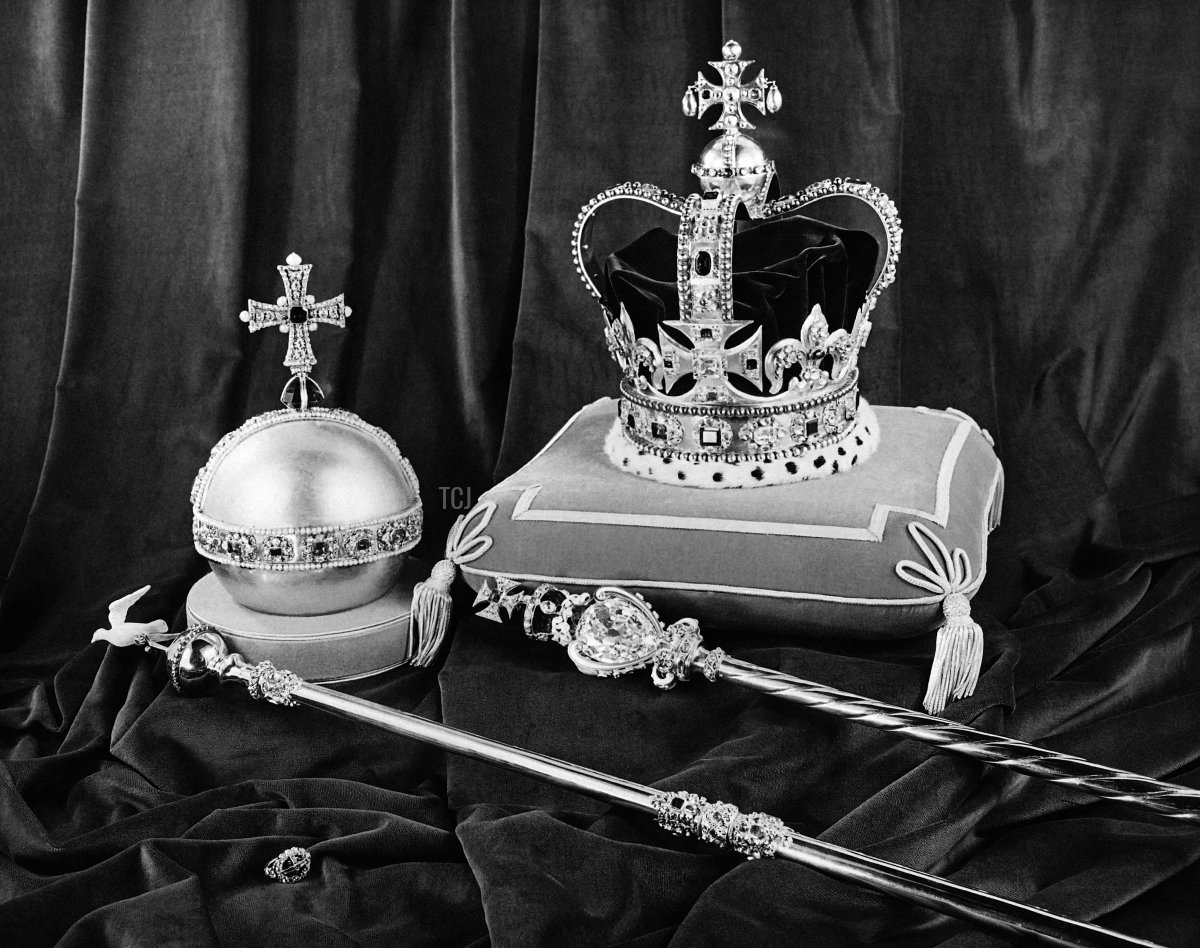
So those are the major pieces we’ll be seeing in the Abbey on Coronation Day. I’m pretty excited to see the regalia in action, having seen it multiple times in person at the Tower of London over the years. Which parts of the coronation service are you most interested to see?
Leave a Reply
You must be logged in to post a comment.